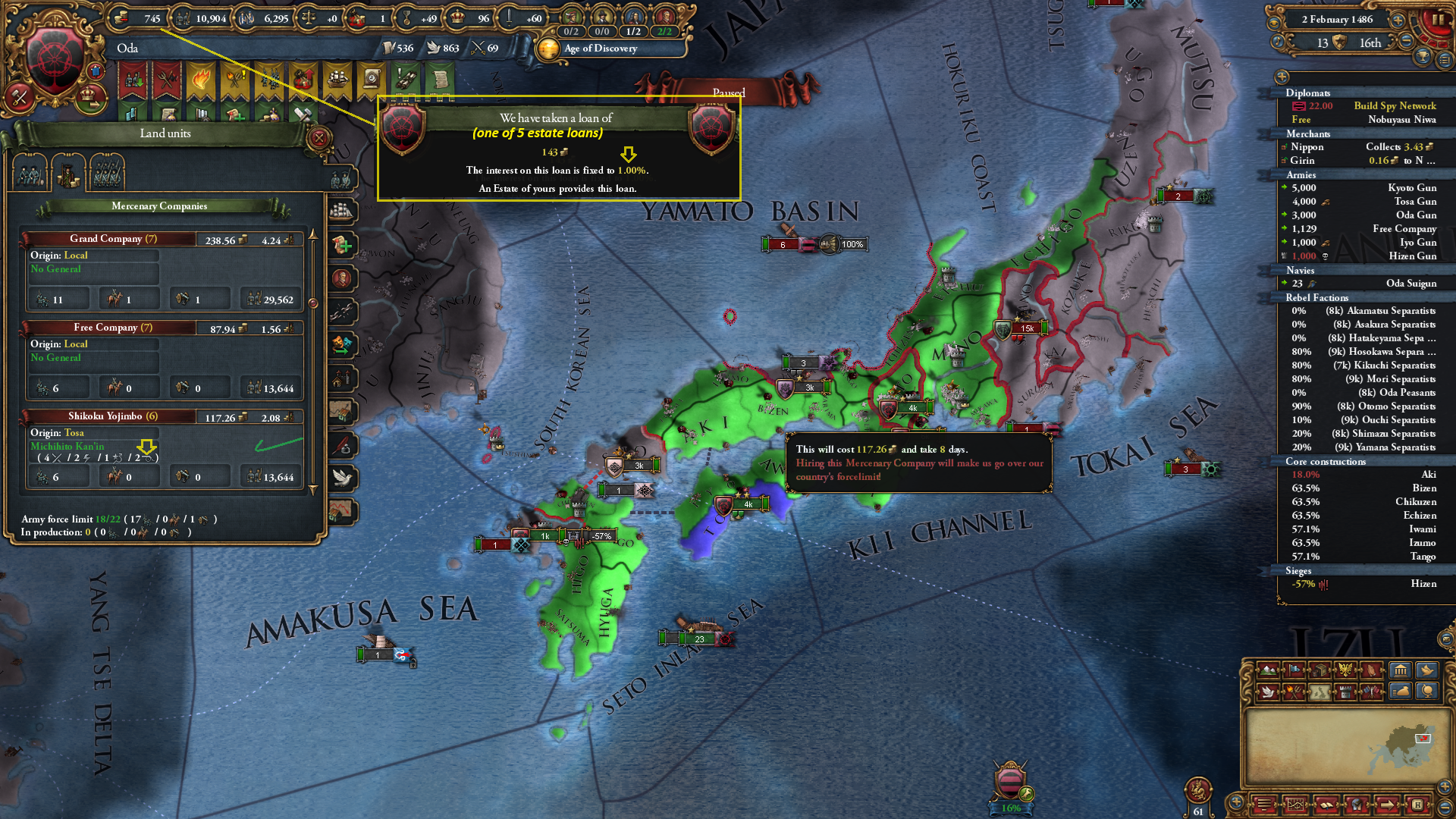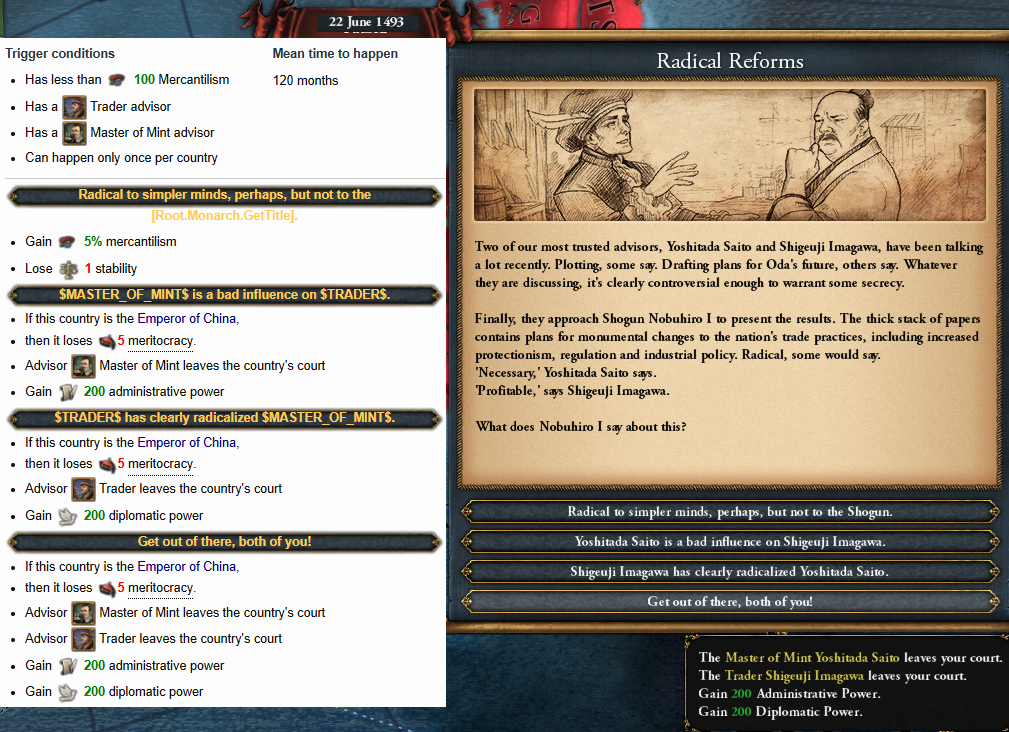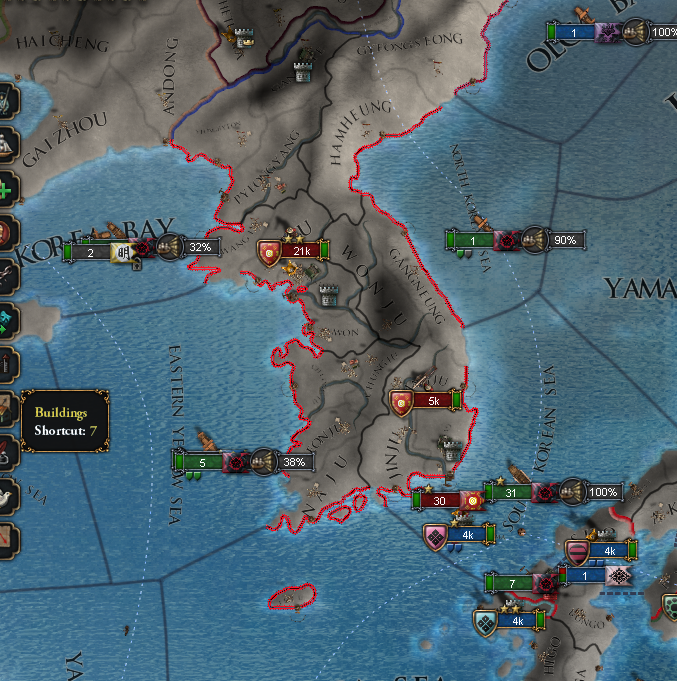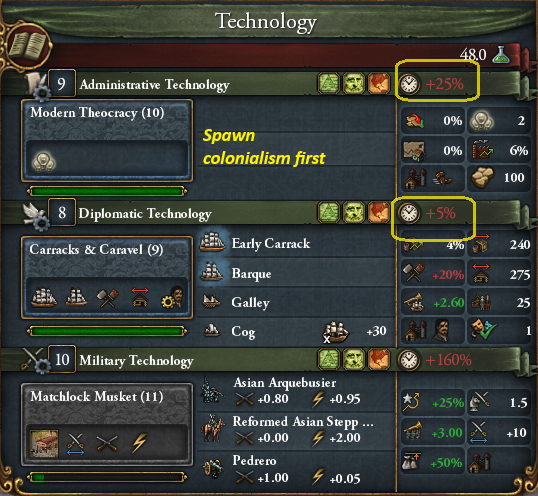Chapter 6: Toehold then foothold (1500-1510)
The first action of the new decade was recovering the stability of the nation after the passage of the comet
This was made slightly easier by the 7 Daimyos who lightened up the administrative cost. This had to be done during peace time to get that help (h/t
@Steckie ). And only after doing that , did Oda declare war on Ming
The Japanese navy was larger than the Chinese navy . And the latter remained at port in Beijing, blockaded by the main Oda fleet.
Oda then sent small squadrons to blockade the other provinces of Ming
With the war on Ming going well, Katsunaga felt emboldened enough to declare war on Orochoni, who had annexed Ainu and the island of Hokaido
Japan cited conquest as the casus belli, and quickly moved to occupy the province in question. The Shogun was planning on a simple passive war with the Odan army sitting on the war goal He had no intention of diverting the fleet from China to attack the Orochoni . But what he did not count on , however, was the size of the Orochoni fleet which turned out to be 17 ships, with several galleys.
At that size, the Orochoni fleet presented a danger to the small Japanese squadrons blockading the Chinese coast. So Katsunaga ordered the fleet to reassemble and chase the Orochoni.
However, the slow galleys prevented the Odan navy from catching her enemy who retreated back to their home water. But on the way back, the fleet ran into the Ming fleet which had ventured out. That was the only naval battle in the war, and was a clear Japanese victory .
After that the Chinese fleet withdrew to Ningbo and never ventured again . And Oda proceeded to blockade all the Chinese coast except their southernmost provinces ( which were out of supply range of the Japanese navy) .
The blockade had a beneficial effect on Oda, who collected a nice monthly sum of around 8 to 11 ducats from this . And had a detrimental effect on the Ming Emperor's mandate through the effect of devastation of the coastal provinces ( h/t
@jak7139 ). This effect was minor at this time, but would certainly rise as time went on and devastation increased.
As for the war on Orochoni, the Odans got a nice assist from Haixi who declared a tribal feud war on the Orochoni.
Oda hoped that with Orochoni mainland provinces occupied by Haixi the former would be more ready to negotiate away their holdings on Hokaido . But what actually happened is that Haixi annexed a chunk out of Orochoni.
And although omens in the sky ( a second comet in just 3 years!) were unfavorable, Katsunaga considered this a propitious event. Because the Orochoni were now at a size that can have them become vassals ( and therefore the 8th Daimyo) of Oda.
Meanwhile on the internal front, Oda completed her 4th national idea, the Influential Stronghold , permanently adding siege skills to all her future generals .
And then another development in the Orochoni situation happened : Jianzhou declared war on the beleaguered Orochoni.
That event gave significant urgency to Katsunaga's plans to vassalize Orochoni. That was because Jianzhou was a tributary of Ming, and so was relatively safe from an Oda attack. And if Jiangzhou annexed all the mainland provinces of Orochoni, then Oda would lose the chance to gain a foothold on the Asian continent. But if Oda could vassalize Orochoni before Jianzhou completed her war on them , then Oda would get to fight Jianzhou in a defensive war as Orochoni's overlord.
So the Shogun quickly wrapped up the war with Ming, taking only money
The premature end to that war meant that the devastation brought by the blockade, which was just starting to get felt in Beijing, would not drastically affect the Emperor's mandate of heaven . But on the positive side, Oda got a large sum of money, enough to pay off all her loans and then some . And with the fleet free from blockade duty in China, the army was quickly transported to the Orochoni mainland. And in a stroke of good luck, the Odan army managed to reach the enemy capital Oroch just before Jiangzhou made it there.
And after the fall of the enemy capital, peace was imposed on Oroch
Oroch became a Daimyo of Oda ( and a loyal one at that) and Oda annexed all of Hokaido and the Kuril islands. And Oda became war leader against Jiangzhou
The war against Jjangzhou was easy for Oda. But Katsunaga feared the effects of that war on Oda manpower, and so decided to spend some of the left over Ming money on hiring the Grand Company mercenary company .
Between the mercs, the help from Orochoni, and the regular troops, the enemy was quickly overwhelmed. And after their capital fell, were quickly turned into the 9th Daimyo.
Oda started the war on Orochoni with hopes of taking Hokkaido and establishing a toehold in Asia. But now thanks to vassals, she had a good foothold on the Continent. And she has grown enough to eclipse her former rival Korea
At that point Oda looked to see if she could expand her continental holdings more. Unfortunately Haixi was a tributary of Ming. And Oda did not feel strong enough yet to attack Ming. So instead, Katsunaga began the preparation for the invasion of Korea when that truce would run out in 1509. The armies that had just conquered Jianzhou were stationed in the land of the new Daimyo and prepared to invade Korea by land . And in support of that effort, Katsunaga declared the mission to "Win Political Supremacy" complete and obtained claims on Southern and Eastern Korea as a result ( plus a good bit of power thanks to prestige being quite high).
But before we get on with the narrative, we will mention the beginning of a second Shinto religious incident: the arrival of the Wokou pirates
Katsunaga followed in the footsteps of Hisanaga and took the isolationist view of the pirates.
After that his attention returned to foreign affairs. And in February 1508 he received the Ho-hum news of Haixi annexing one province minor Korchin. He did not pay much attention to that. but the next month there were dramatic changes in the map. Haixi renamed themselves to Manchu and broke off their tributary relation with Ming. And the latter suffered a collapse in their Mandate .
That presented new opportunities for Oda . With no mandate , the Chinese were ripe for an attack . But unfortunately, Japan was still bound by a truce with them . Manchu, on the other hand, had no such truce with Oda. And with no overlord, and no allies, Manchu was particularly vulnerable to an attack by Oda. So taking advantage of the the troops already positioned to attack Korea, Katsunaga immediately declared war on Manchu and began the Japanese invasion of Manchuria.
The Odan armies quickly marched on the enemy capital of Girin. And after a siege of 131 days it was taken. The two forts to its west followed suit
During that time the Manchu armies did not challenge Oda's force, and instead spent their energy on Oda's vassals Orochoni and Jianzhou. And when the Odan forces approached them , they promptly withdrew to the Siberian wilderness, leaving all Manchuria and their vassal Solon in Japanese hands.
And that brings us to the end of the decade.
Oda's finances are in the red currently due to the use of mercenaries . Her troops are not at force limit thanks to contributions from her vassals. ANd this will only get better as the Influence Ideas are completed. BUt a lack of manpower may force Oda to continue using mercenaries . And Katsunaga has a few big decisions to make soon.
First, should he attack Ming instead of Korea next?
Second, should he pause the advancements in technology and ideas to spawn Colonialism , or is getting the next idea group a higher priority?
Third , what should that idea group be ?
Fourth, should he declare a Golder Era now or save it for later?

























































































